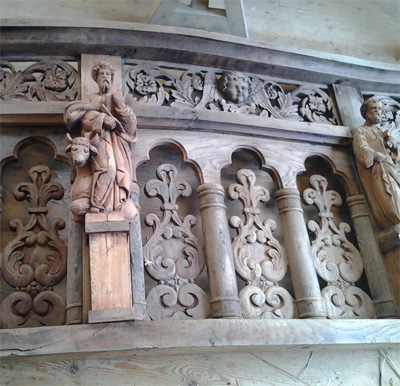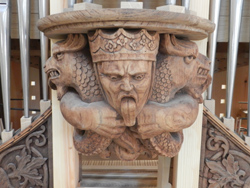

Organ : 1 keyboard (54 notes : C1 à F5) , French pedalboard ( pedalboard of 13 notes ) - 9 stops

The origin of this organ is unknown. We could be able to date the pipework from the end of the 17th century, but the windchest seems rather from the 18th. No archive this day was able to be found. The sound esthetics of the instrument is however in accordance with the 18th French classic style.
Composition :
| Bourdon 8' |
| Prestant 4' |
| Nazard 2 2/3' (basse et dessus coupée à F3) |
| Doublette 2' (basse et dessus coupée à F3) |
| Tierce 1 3/5' (basse et dessus coupée à F3) |
| Dessus de 8' ouvert à C3 |
| Plein Jeu 3 rangs (1, 2/3, 1/2) |
| Trompette 8' (basse et dessus coupée à F3) |
| Cromorne 8' |

Architecture and acoustic context:
Its situation in the building : a gallery in the bottom of the nave. This one consists of a floor held by two metallic splints sealed in the bottom wall. The access was formerly made by the back and by a narrow and unworkable staircase. A new staircase was implanted on the front on the occasion of the restoration of the organ. The precise and relatively short acoustic (approximately 2 seconds of reverberation) allows a natural development of the sound without any distortion.

Case : Oak / fir tree for the structure; the surprising decoration in carved elm is rather composite just like that of the balustrade. These elements come very probably from another organ. Some of these sculptures are without ambiguity of the 16th century, can be 15th for some of them.

The mechanics is usual for this type of instrument : keyboard centred in tail situated behind the case and suspended. The wind is produced by a cuneiform bellow situated on the side of the organ.
The harmonization was established on a wind pressure of 72mm. The temperament, (A3 of Prestant = 440hz in 16 °) is the one of Rameau in C, simplified (4 right thirds). The pipes are of pure lead for certain ranks such as the Bourdon, the Prestant, the Doublette, the Nasard and Tierce, and of tin for the rest.

Restoration work :
The elements constituing the instrumental part, the case and its decoration were most probably settled in the second half of the 19th century, period in which was built the gallery. The instrumental part consisted of a diatonic windchest of 54 notes cut off from F3 in basses and trebble, except for the "Plein jeu". There were still 2 rollerframes, one of 12 notes in pedalcoupler for a small disappeared pedalboard and the other one for a keyboard, both, out of service. The window of the keyboard, situated behind the case, included a modern piano keyboard in ¾ destroyed.
The stop action, on the other hand, was complete with the peculiarity of rollers of oaks elegantly lathed in the extremities. On the gallery there was a bellow dawdles and its pump, also out of service.

The pipes, in big disorder, preserved however enough elements to complete the lacks without ambiguity. Certain stops as the Doublette (of big size), the Bourdon, the Nasard, the Tierce, are made of pure lead very thick with curious plan's lines on bodies. The trebble of 8 feet is, on the other hand, made of tin just like the rests of the "Plein Jeu". We noted however two reeds stops made of zinc of industrial production in the 20th century. The facade of origin was probably requisitioned and melted at the beginning of the 1st world war. A few years later, a joiner and his son always alive at present ( 99 years) redid a lathed wooden facade. A part of these pipes is always visible today, it composes the facade of the false "positif de dos".
The organ was dumb and out of service for at least 70 years. However, some old inhabitants of the Village of Moult, can testify to having heard this organ during their youth.
The works of restoration concerned the reorganization of all the instrumental part , the creation of a cuneiform bellow, a construction of some new keyboard and pedalboard. The complete restoration of the windchest, the restoration and the complements of the ancient stops, the creation of two reed stops : Trumpet 8' and Cromorne 8' built in forged tin, and of an approximately 6 feet facade made of tin.